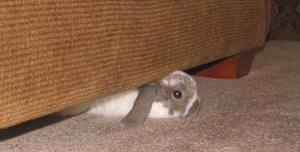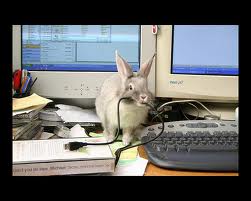Bunny-proofing means making your house safe and secure for your rabbit. It is extremely important and can be the difference between life and death. Rabbits can get into trouble very easily. They are quick and quiet, and an unsuspecting owner may not realize that the rabbit is in a dangerous situation until it is too late.
Taking precautions to bunny-proof your rabbit’s exercise area is a must for any responsible rabbit owner.
First of all… you need to get down on your tummy at your rabbit’s level and see what potential dangers lie in his path.
Dark Areas
Rabbits love dark areas. 
Be sure to block all openings that your rabbit can crawl into, including areas behind furniture and appliances and entrances to ductwork.
Cardboard, plexiglass, wood panels or NIC’s can be used to limit access to such areas.
It’s best to keep your rabbit away from the underside of sofas and beds, because
he may chew holes in the liner and crawl inside. If your rabbit eats the stuffing inside of your sofa or box springs, he may become very ill.
These areas can also be blocked off by cardboard boxes, wooden frames or NIC fences. If you can’t make these areas completely inaccessible to your rabbit, a
daily inspection underneath the furniture is a good idea to ensure that no chewing has taken place.
Electrical Cords
Electrical Cords are very dangerous. If your rabbit chews them, he could be severely 
burned or electrocuted.
Rabbits are very inquisitive, so hiding the cords rarely works. It’s best to err on the side of safety, and make your cords inaccessible to your rabbit.
Cords should be concealed in flexible plastic tubing, which can be purchased in various
sizes at most hardware and aquarium stores. Canadian Tire sells flexible plastic tubing
for housing car engine wires in their automotive department. This type of tubing can be
cut lengthwise with a utility knife or scissors so the cords can be slipped inside, and
hidden away from a curious bunny.
Spiral cable wrap, which is sold at Radio Shack, Canadian Tire and Home Depot, can be wrapped around cords and wires to protect them as well.
Off Limits!
Some areas of your home, such as home offices, may not be able to be adequately bunny-proofed and may always remain off limits to your rabbit. This can be done by closing the door or installing a baby gate.

House Plants
Household plants should be kept out of reach of your rabbit because many are toxic. Be forewarned that rabbits can jump onto end tables or climb onto furniture and reach plants you thought were out of their grasp. Hanging the plants from the ceiling or putting them high onto window ledges are better choices, but watch for falling leaves. Also, make sure all plastic or dried flowers arrangements are inaccessible to your rabbit as well.
Unstable Surfaces
It is also important to make sure your rabbit cannot jump onto any unstable surface, which he could fall off and injure himself. Fasten an
old towel to the top of his cage with zipties so that if he does jump onto the top of his cage, he will not get his foot caught in the wire when
jumping back onto the floor.
A Final Note:
Until an area of your home is properly bunny-proofed, make sure that your bunny is in a cage or exercise pen for his own protection, and only let out under your supervision. Bunny-proofing can be relatively easy, and providing an area for exercise is so important to your rabbit’s well-being. Rabbits can be litter trained, and as they mature and are spayed or neutered, they become more calm and relaxed. Depending on the extent of your bunny-proofing expertise and your rabbit’s personality, your rabbit may be allowed to roam free in an area of your house. It is not recommended that very young rabbits or first time owners allow their rabbits to roam free immediately because of the dangers we have listed. It is best for rabbits to gain freedom gradually so that they are not overwhelmed and become destructive.

